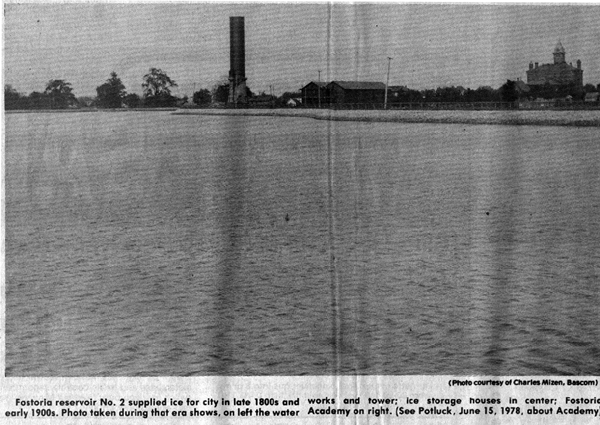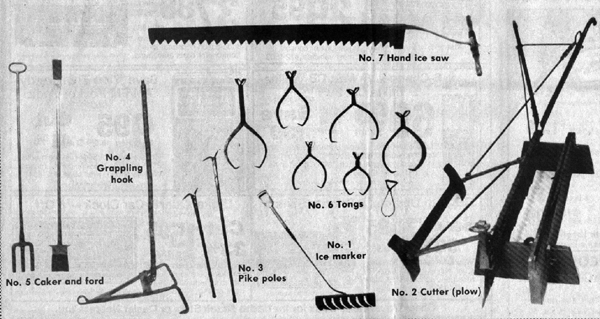August 5, 1982


Picture #1 – Fostoria reservoir No. 2 supplied ice for city in late 1800’s and early 1900’s. Photo taken during that era shows, on the left the water works and tower; ice storage houses in center; Fostoria Academy on right.
Picture #2 – pictures of the following tools: Hand ice saw, Tongs, Grappling Hook, Caker and ford, Pike poles, Ice marker, Cutter (plow).
Author’s Note: Today’s article is the first of two installments about ice harvesting in an era before electric refrigerators.
Do you remember when ice was used to refrigerate food in the home? If you do then you belong to the “older” generation; well, let’s say you would be 50 or more.
Where did the ice come from and how was it preserved for use to keep food from spoiling? That’s what today’s story is about, plus an explanation of the two year research I conducted to draw together all the elements for this article.
Several readers had reminded me that at one time ice had been cut from Reservoir No. 2, so I started a search for a photo which would show the houses where the ice was stored for summer use.
Later, I learned from Loy Luman, Jackson Street, that Sam Luman, his father now residing at Edgewood Manor, was probably the only living person in Fostoria who was part of the work crew who participated in ice harvesting. However, Luman did not have any photos or know of any, showing the tools needed to cut ice.
OLD CUTTER STILL LIVING
About that time, The Review Times published an Associated Press (AP) story about a man named Charles Clark who grew up in Old Greenwich, Conn. and still lives there, who took part in harvesting ice when he was just a teenager.
Clark has spent a lot of time in recent years collecting the tools they used back then and has been lecturing to young Americans about the forgotten art.
Why is Clark so serious about his effort? He says, “When we run out of oil.. . I do not say if we run out, but when…ice will be as necessary as it was before the days of the electric refrigerator. I’m one of the few remaining who knows how to harvest it”.
Clark often draws a group of 100 or more to see the complete set of tools and listen to the story of their use.
“It wasn’t easy work. We worked from dawn to dark in bitter cold. The idea was to get two ice harvests each winter, if possible. Clark said.
And we had to cut it all just the right time. Honeycombed ice, caused by alternate thawing and freezing was no good. The ideal was a 12-inch thick block of ice. We started cutting when the ice was 10 inches thick and had it harvested before it was 14 inches. Any thicker and it became too difficult to get.
SET OF TOOLS SURVIVES ERA
Clark worked diligently to assemble a complete set of ice harvesting tools and they are lodged at The Stamford Museum and Nature Center, Stanford Conn. where he often delivers one of his lectures.
One of the accompanying photos show the complete set and identifies each. No. 1, marker for scoring the surface of the ice prior to cutting; No. 2, horse-drawn cutter (or plow) to cut through the ice except the bottom two inches; No. 3, pike poles for pulling or pushing the ice cakes; No. 4, grappling hook used to pull long rows of blocks into the ice house with block and tackle and horse; No. 5 ice caker and fork, used to break or split ice into separate blocks; No. 6, various size tongs for handling separate blocks of ice when storing it in house and for removal and No.7, ice saw, used for hand cutting.
Clark explains in his lectures how a horse was hitched to the ice plow and how the plow cut all but the bottom two inches of the ice, and how it was then rafted to the ice house, where it was broken into the uniform size.
“I want somebody around in the next generation who knows how to use these tools”, Clark points out in his lectures. Look at the curve of the teeth in that plow, how each tooth is a different size to facilitate the cutting job.
LUMAN TELLS OF ICE CUTTING
I was able to procure a set of prints of the tools from the museum. When they arrived, Loy Luman and I went to Edgewood Manor to see his father and talk about his ice cutting days. Sam’s part in the local ice-cutting business was to run the boiler house, where steam was generated to operate the conveyor which carried the ice into the storage house.
Even though he was not involved in the actual cutting, Sam recalls very well, at age 92, what went on in the somewhat dangerous business.
Here in Fostoria after the ice was cut, as previously explained, it was propelled through the open channel of water by the use of the pike poles by manpower to the ice house, where the conveyor took over to carry them into the house.
The finished blocks, cut to size were stored four tiers high. As the long blocks still joined, traveled up the conveyor, workers used the ice caker and ice fork to break the long cake into finished size as they neared the door of the ice house. When the house was filled with the first tier of ice blocks, the conveyor was moved so that the ice then entered the house through a door at a higher level and the operation was continued until all four levels were used and the house was filled.
As we talked about the Fostoria ice-making procedure, we tried to arrive at a production figure. It was estimated that they cut and stored at least 60,000 pounds per hour and back then a workday was usually more than eight hours.
YOUNG CUTTER NEARLY DROWNED
Sam Luman, like Clark, recalls that ice-making ws hard and cold work, also dangerous.
One day one of the younger workers was using a pike pole to move a string of ice. In some way he lost his balance and slipped into the water and under the ice. His father, close by, used a pike pole to reach under the ice and fortunately was able to snag his clothing and pull him out. Before they got him to the boiler house to warm, his clothes were frozen solid. Inside the boiler house he soon thawed out and none the worse for the experience, Sam said.
Because ice-cutting was such a cold job, there was always a jug of whiskey available for the workers, according to Luman.
But, let anyone show any signs of overdrinking or intoxication, and they were dismissed from their job, Luman said.
Luman also recalls that Frank Keibel who in later years was associated with Kiebel and Wilson Dry Goods Store, was involved in Fostoria’s ice-cutting operation. Although not sure, he thinks he may have been manager, because he always set out the jug of whiskey. Who the owners or stockholders were, no one seems to know.
With a good harvest of ice, Luman said they would have enough to supply the town for the months when it was necessary to have ice to preserve food. Sometimes there would be some left over.
The storage houses, shown by one of the photos, were frame structures of double wall construction with 12 inches of sawdust used to insulate the walls.
1913 LAST CUTTING IN FOSTORIA
Luman says he believes 1913 was the last year ice was harvested from the reservoir in Fostoria. By that time The Fostoria Ice & Coal Co., headed by Harry Clore and Ralph Clink, had started to make ice in their plant on East North Street. Schreiner Construction Co. now occupies that building.
According to Kenneth Souder, Jackson Township Road 41, one of the last employees of The Fostoria Ice and Coal, it closed in 1963. By then the electric refrigerator had totally replaced ice as a means of preserving food.